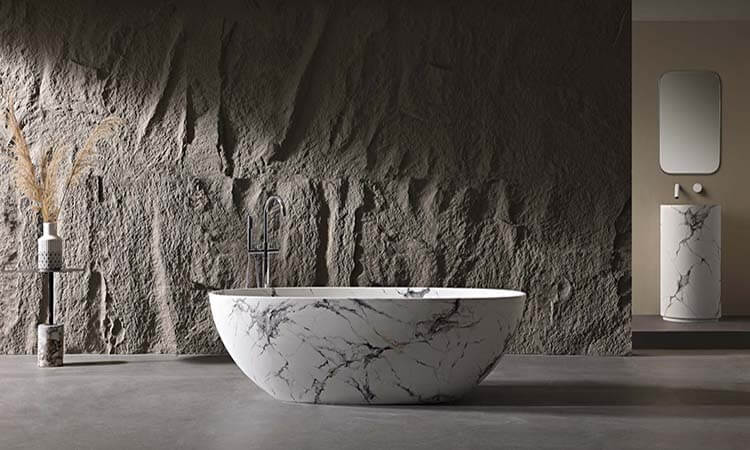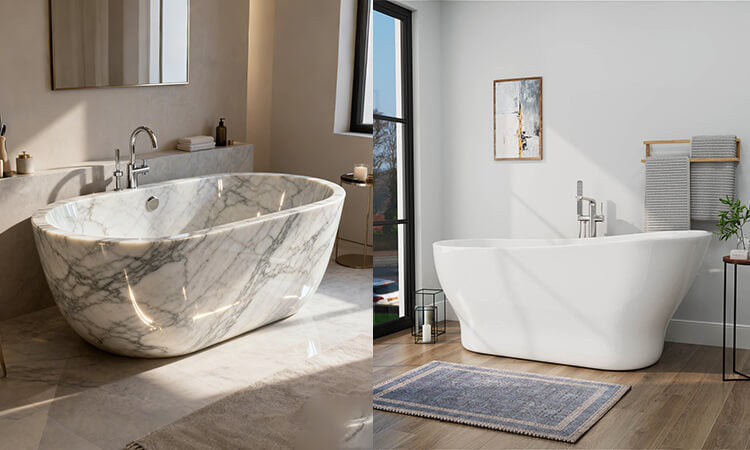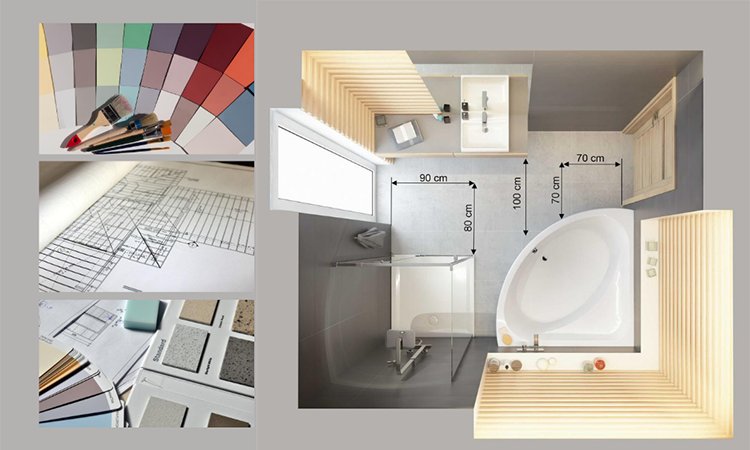When it comes to designing your dream bathroom, choosing the right bathtub is all about balancing style with practicality. Marble and acrylic tubs each offer a unique experience: marble is prized for its natural elegance and luxurious feel, while acrylic stands out for its lightweight construction and budget-friendly appeal.
According to the 2024 National Kitchen & Bath Association (NKBA) survey, these two materials account for more than 75% of the U.S. bathtub market, with acrylic leading in popularity and marble holding a smaller but still significant share.
For many homeowners, the choice comes down to a simple question: do you want timeless elegance or everyday convenience? In this guide, we’ll compare marble and acrylic tubs across four key areas—material properties, user experience, maintenance, and best use cases—so you can make an informed decision and find the perfect fit for your bathroom.
1. Material Essence: Understanding the Core Differences
Marble Bathtubs

True marble tubs are either carved from a single block of natural stone or made by combining marble chips with resin—not just printed with a synthetic marble pattern. Their standout qualities include:
- Unique Natural Patterns: Every marble tub is one-of-a-kind, from the crisp white veins of Carrara to the warm, dramatic swirls of Calacatta.
- High Material Density: Natural marble is dense—about 163 lb/ft³—while composite marble tubs still exceed 113 lb/ft³.
- Gentle Heat Retention: Unlike metal, marble warms slowly and holds heat longer, keeping your bathwater cozy.
That said, marble has its drawbacks. A standard full-size tub (about 5½ ft long) can weigh 660–1,100 lbs, so your floor needs to support heavy loads. Plus, natural stone is porous; if not properly sealed, it can stain over time.
Acrylic Bathtubs

Acrylic tubs, made from PMMA (acrylic resin) reinforced with fiberglass, are among the most popular choices today. Their key benefits include:
- Lightweight: Acrylic has a density of roughly 69–75 lb/ft³. A 5½ ft tub typically weighs just 110–175 lbs, making installation easier without needing floor reinforcements.
- Flexible Design: Heated and molded, acrylic can take virtually any shape—round, oval, or fully customized—and comes in a wide range of colors and finishes.
- Smooth, Seamless Surface: Polished acrylic feels soft to the touch, while seamless joints make cleaning effortless.
- Warm to the Touch: Unlike marble or metal, high-quality acrylic doesn’t feel cold.
However, acrylic isn’t indestructible. Its surface is relatively soft (Mohs hardness 2–3), so it can scratch from metal objects like razors or faucets. Prolonged exposure to high heat (over 176°F) may cause warping or yellowing.
2. User Experience Comparison: Appearance, Comfort, and Durability
Appearance and Style Compatibility
Marble’s natural patterns exude luxury and often become the centerpiece of any bathroom. They pair beautifully with modern minimalist, French-inspired, or contemporary high-end designs, instantly elevating the room’s atmosphere. In upscale U.S. homes, marble tubs are often paired with stone countertops and brass fixtures for a “five-star hotel” vibe. The downside? Marble’s elegance can feel out of place in industrial, rustic, or playful-themed bathrooms.
Acrylic stands out for its versatility. With endless colors, shapes, and finishes, it works in minimalist spaces, kid-friendly bathrooms with playful designs, or even faux wood and stone looks at a fraction of the cost. Acrylic can also be custom-fitted to small or irregular spaces, like corners or uniquely shaped bathrooms. The trade-off is texture—faux patterns don’t fully capture the depth of natural marble, and up close, some finishes may feel slightly “plastic.”
Comfort
Marble tubs conduct heat quickly, which can make them feel cold in winter unless preheated. Acrylic, on the other hand, warms slowly and feels pleasantly mild in cooler weather. On hot summer days, marble’s natural coolness can actually be refreshing.
Acrylic’s moldability allows for body-contoured backrests (like a 110° recline), textured non-slip bottoms, and even high-end options like massage jets or built-in thermostatic heating. Marble tubs, due to their rigidity, usually stick to classic shapes, and adding advanced features can get expensive.

Durability
Marble’s higher density and hardness (Mohs 4–5) make it resistant to scratches, dents, and everyday wear—dropping a shampoo bottle rarely leaves a mark. Acrylic is softer, so it can scratch more easily and gradually lose its shine.
A well-crafted marble tub can last 15–20 years without yellowing. Acrylic tubs exposed to sunlight or high heat may yellow or warp after 5–8 years, though regular waxing can help extend their life.
3. Maintenance Costs: What You Need to Know for Long-Term Use
Purchase and Installation Costs
A solid natural marble tub (about 5½ ft long) typically costs $5,000–$15,000, while composite marble (solid surface) runs $2,000–$5,000. Installation can be tricky—moving a heavy marble tub often requires a crane or several movers. You may also need to reinforce the floor, which can add another $500–$1,000 to the total cost.
Acrylic is much more budget-friendly. A standard 5½ ft tub costs $800–$2,000, while high-end models with features like massage jets can reach $2,500–$4,000. Installation is simpler—usually 2–3 people—and no floor reinforcement is needed, keeping labor costs around $200–$500.
Daily Maintenance Costs
Marble Bathtubs:
- Sealing: Initial sealing with stone sealant ($100–$200) is required before first use and should be reapplied every 1–2 years.
- Cleaning: Use neutral cleaners, like mild soapy water. Avoid acidic cleaners (e.g., toilet cleaner) to prevent surface damage.
- Stubborn Stains: For tough stains like red wine or hair dye, stone-specific stain removers cost about $50–$100 per treatment.
Acrylic Bathtubs:
- Cleaning: Use a soft cloth and neutral cleaner. Avoid steel wool or harsh abrasives that can scratch the surface.
- Scratch Repair: Minor scratches can be fixed with acrylic repair kits ($30–$50 per bottle), while deeper scratches may require professional repair ($200–$300).
- Maintenance Wax: Applying acrylic maintenance wax periodically ($20–$40 per bottle) helps prevent yellowing and extends the tub’s lifespan.
4. Suitable Scenarios: Which Bathtub Fits Your Home?
Who Should Choose Marble Bathtubs
- Luxury-focused homeowners: If you’re aiming for a high-end look and a long-term investment, marble tubs are a perfect fit. In large homes or upscale villas with budgets over $5,000, a marble bathtub isn’t just a fixture—it’s a statement piece that adds sophistication and value.
- Spacious bathrooms: Marble tubs need both room and support. Bathrooms around 86 sq ft or larger with floors that can safely hold heavy loads are ideal. Pairing a marble tub with natural stone countertops or floor-to-ceiling windows can create a spa-like, immersive experience.
- Those who prefer longevity: With proper care, marble tubs can last 15–20 years. They’re ideal for families who want a long-lasting centerpiece without frequent upgrades.

Who Should Choose Acrylic Bathtubs
- Budget-conscious families: If your budget is between $800–$3,000 and you want versatility—like built-in massage jets or temperature control—acrylic is a smart choice.
- Small spaces or older homes: Acrylic’s lightweight design and flexible shapes (corners, odd dimensions) make it perfect for apartments or older homes with lower floor load capacity.
- Trendsetters who like to refresh their style: Affordable and easy to replace, acrylic tubs let you update your bathroom design every few years without overspending.
Ending
There’s no single “better” bathtub—only the one that fits your lifestyle, space, and budget.
At Giving Tree Home, we understand that some homeowners love the look of marble but are put off by the price. That’s why we offer marble-look tubs made from solid surface resin. They capture the elegance of natural marble, stay budget-friendly, and thanks to molded construction, can be designed ergonomically for maximum comfort. Curious about solid surface options? Check out our guide: Solid Surface Bathtubs vs Acrylic Bathtubs.
Ultimately, the best bathtub is one that’s comfortable, visually appealing, and easy to maintain. Whatever you choose, the tub that helps you relax and unwind is the one that truly fits your home.







